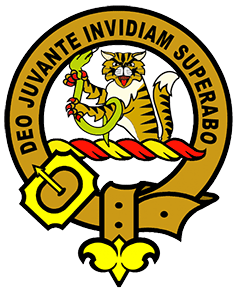MacThomas Clan
MacThomas Clan Crest: A wildcat rampant guardant Proper, grasping in the dexter paw a serpent Vert, langued Gules, it's tail environing the sinister paw.
MacThomas Clan Motto: Deo Juvante Invidiam Superabo (With God's help I will rise above envy).
MacThomas Clan History: Tomaidh Mor, meaning 'Great Tommy', was a descendant of the Clan Chattan Mackintoshes and lived in the 15th century. At this stage, the Clan Chattan Federation had become large and unmanageable, so Tomaidh Mor took his family and followers across the Grampian mountains, from Badenoch to settle in Glenshee. Although the surname is often to be found spelled McComie and Maccomie, in the 16th century, the Clan is on record as being called MacThomas.
In 1600, Robert McComie of Thom, 4th Chief, was murdered, and the Chiefship passed to his brother John McComie of Finegand. In 1644, John, generally known as McComie Mor or Ian Mor, 7th Chief, joined the Marquis of Montrose in Dundee, but after the Battle of Philiphaugh retired to raise cattle. He purchased the Barony of Forter in Glenisla and Forter Castle, which had been burnt eleven years earlier, from the Earl of Airlie. Unfortunately a dispute soon led to a bitter feud between the MacThomases and Ogilvies of Airlie. A lawsuit followed and, after Ian Mor's death, the Clan scattered.
The 10th Chief, using the surname Thomas, settled in northern Fife, his descendants later moving to Dundee where they became successful merchants. Patrick MacThomas of Aberlemno was Provost of Dundee from 1847 until 1853. Other Clansfolk made their way into Aberdeenshire, where the surname became McCombie, Thom and Thomson. A descendant of one of Ian Mor's sons in Aberdeenshire at the end of the 19th century was William McCombie of Tillyfour. He became a Member of Parliament and developed the breed of cattle known as Aberdeen-Angus.
George Hunter MacThomas was appointed Sheriff of Caithness, Orkney and Shetland in 1870. In 1954, the Clan MacThomas Society was formed and, in 1967, George Hunter MacThomas's great nephew, Patrick, was recognised by the Court of the Lord Lyon King of Arms as MacThomas of Finegand, 18th Chief of the Name. The 19th Chief lives in London with his wife, son and daughter. There are today Clan MacThomas members in North America, Canada, South Africa, New Zealand, Australia and mainland Europe.
James Thom (1802-1850) was born in Tarbolton, Ayrshire, where he became a builder's apprentice. He sculpted figures of Tam o' Shanter and Souter Johnnie, characters from Robert Burns' poem "Tam O'Shanter". Thom emigrated to the USA and settled in Newark, New Jersey, where he created replicas of his favourite sculptures.
Places of Interest: Early MacThomas chiefs lived at the Thom, on the east side of the Shee Water. This is opposite Spittal of Glenshee, where the one acre MacThomas Gathering Ground is located. At its heart is the
Cockstane, a large rock surrounded by trees.
There is also a large stone in Glen Prosen known as McComie Mor's Putting Stone, a fresh water spring known as McComie Mor's Well, and at the head of Glen Beannie, a rock known as McComie Mor's Chair.
Castle Forter at Glenshee, which dates from the 16th century, was burned by the Campbells of Argyll in the 17th century. It was restored in the mid-1990s and, although in private ownership, is leased out for seminars and conferences.
Associated family names (Septs): McComas, McComb, MacCombie, MacComie, McHamish, MacThomas, Tamson, Thom, Thomas, Thomason, Thoms, Thomson.
Clan MacThomas display Prints.

